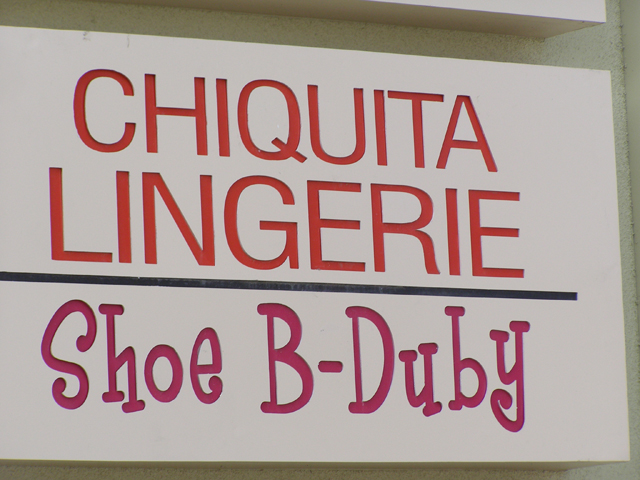
BANANA BASICS
Based on a 2007 California Rare Fruit Growers' Festival of Fruit presentation.
Introduction.

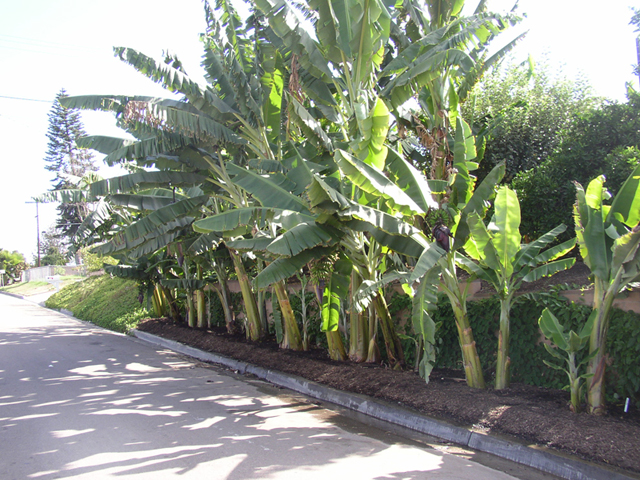
Good afternoon. My name is Jon, and today I am going to be your banana expert because I have more banana trees than most people, and I was willing to talk for cheap.
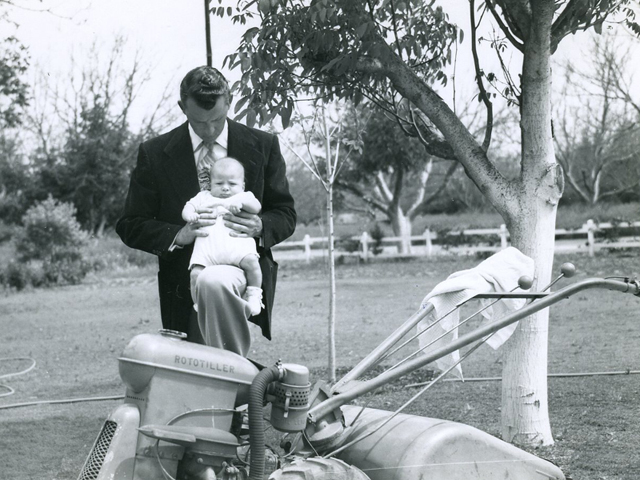
Briefly, I have been gardening since I was in diapers. I joined CRFG nearly 20 years ago, and have been growing bananas for more than 10 years.
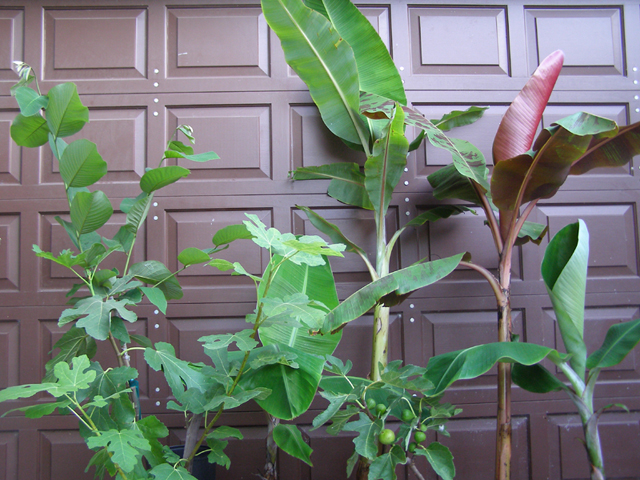
ADVERTISEMENT: I have many banana varieties available at the plant sale outside, along with many of the 300 fig varieties which I grow.

I am a hobbyist like you. I am not a biologist, not a botanist. I do not have any formal education or any formal background in botany or agriculture. So, I am not doing anything that you can't do. CRFG is about experimenting and sharing. I keep experimenting, and hopefully I can shorten your learning curve by sharing my experience
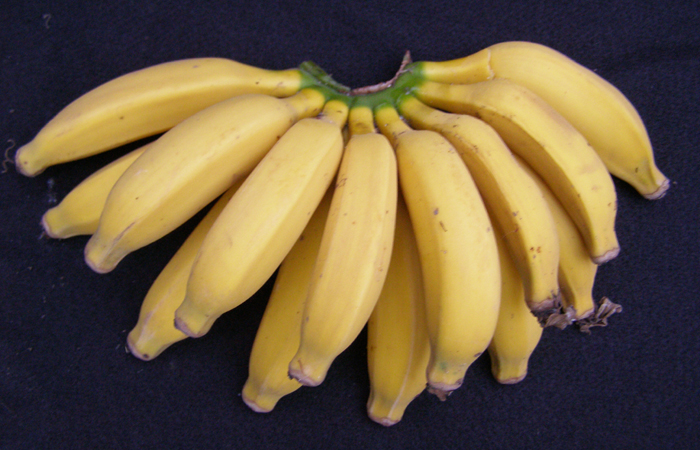
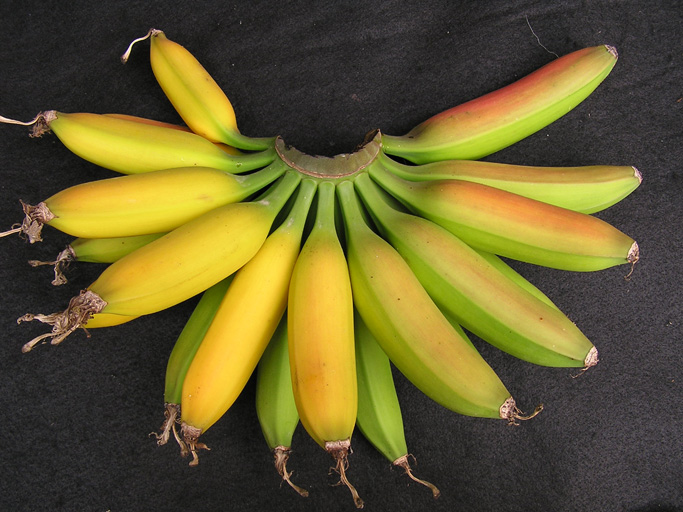
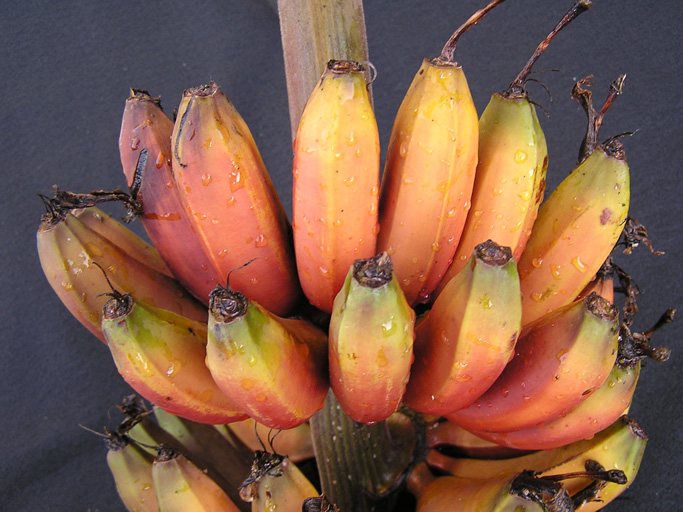
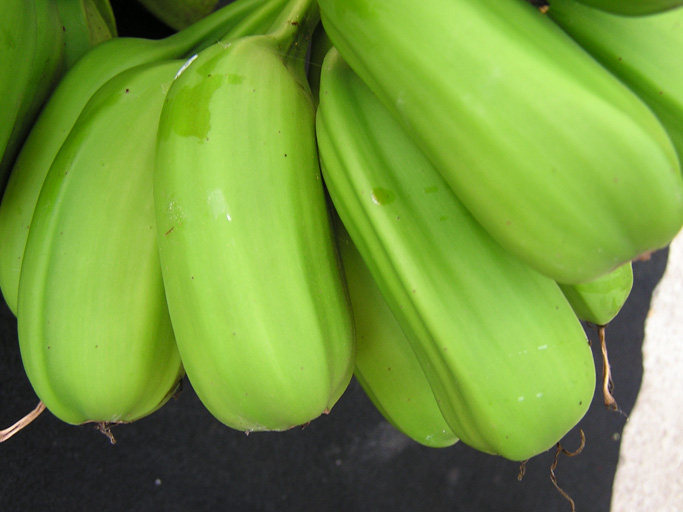
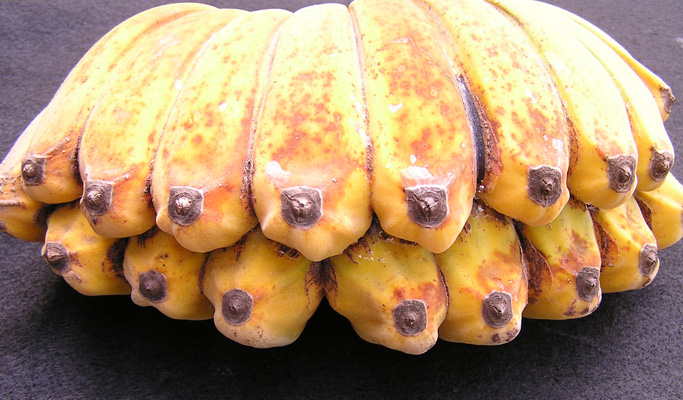
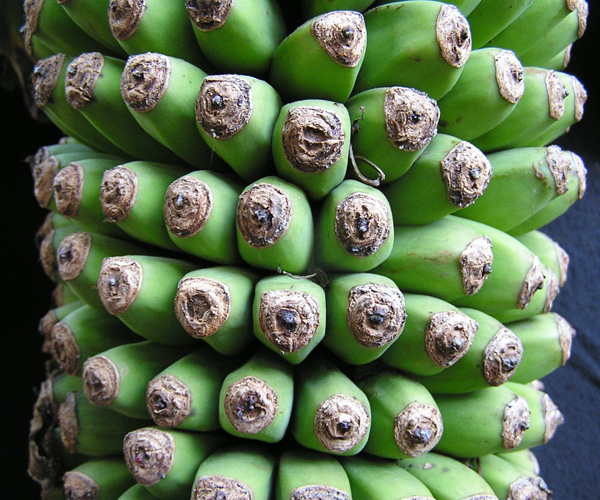
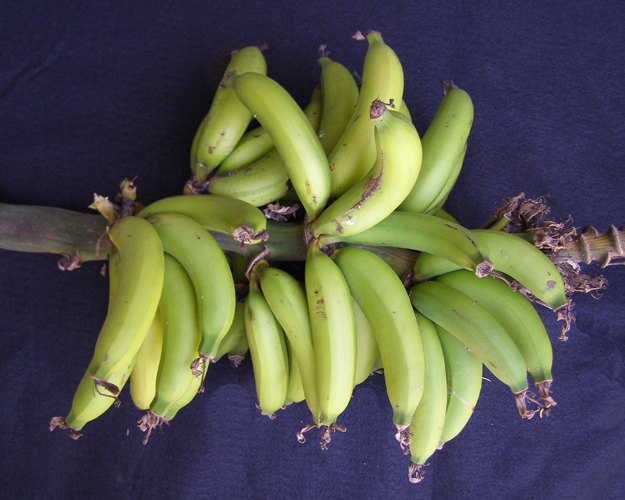
I grow about 100 varieties of bananas, and each has its' own set of characteristics, but the similarities far outweigh the differences.
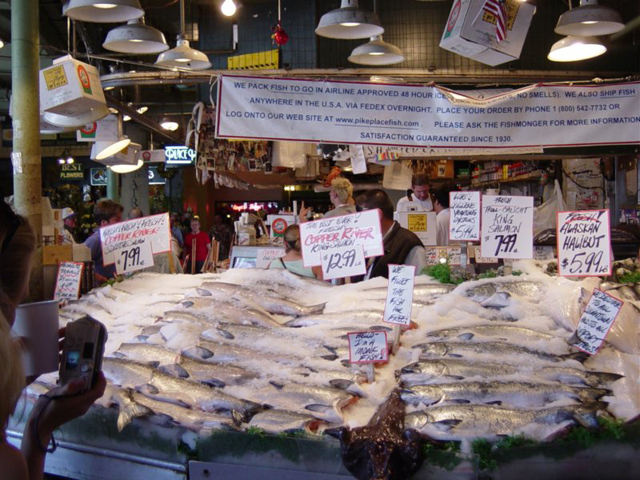
My goal here, as it has been classically expressed, is not to give you a fish...
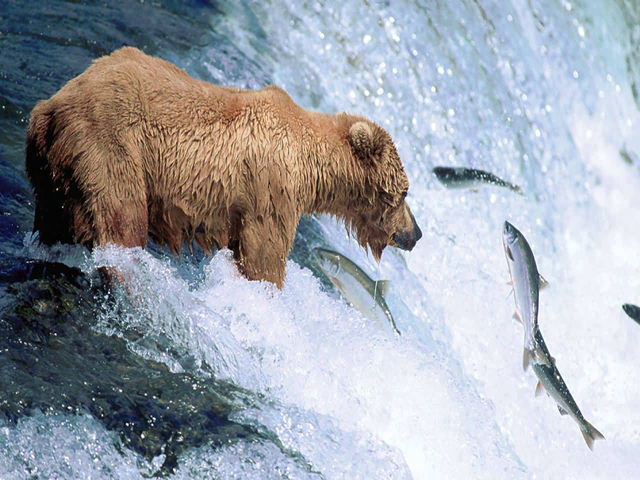
...but to teach you to fish: that is, to introduce you to the basics of bananas, and to help you understand the principles underlying successful banana cultivation, and to introduce you to the information resources available to you, so that you can continue learning and successfully grow any banana.
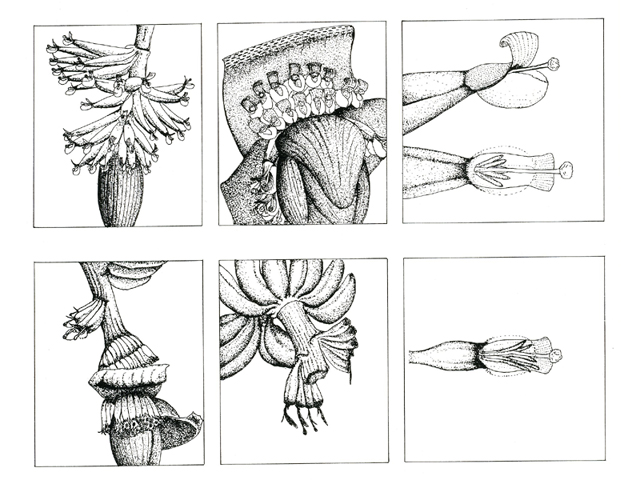
We are not going to spend much time on biology, except where it is important to the successful growing of bananas.

Each variety has many similarities, but also its' differences, and you will hear me say many times today that you need to become familiar with your variety and its' specific characteristics and habits.
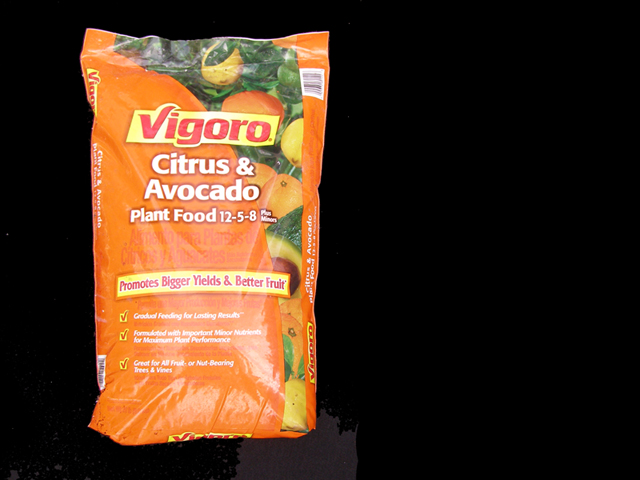
I am biased. I do not grow organically. That does not mean that I am opposed to that form of plant care, only that I am not qualified to address that form of gardening. So if you grow organically, you will have to adapt what I am saying to your situation, which you are probably accustomed to doing, already.
2.
Why grow bananas?
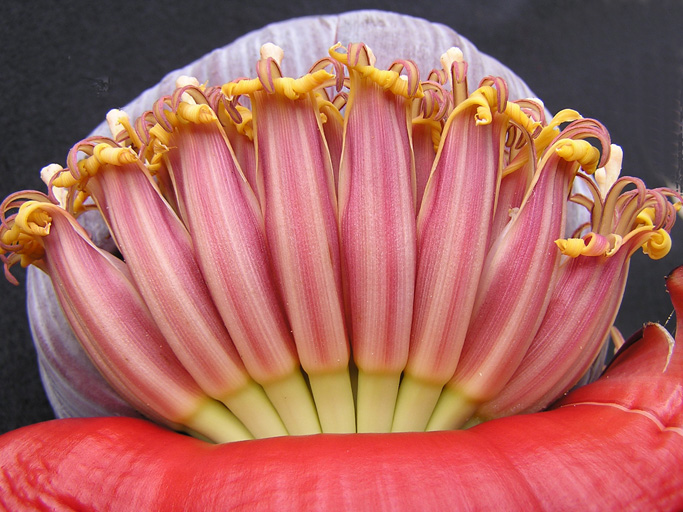
Flowers.
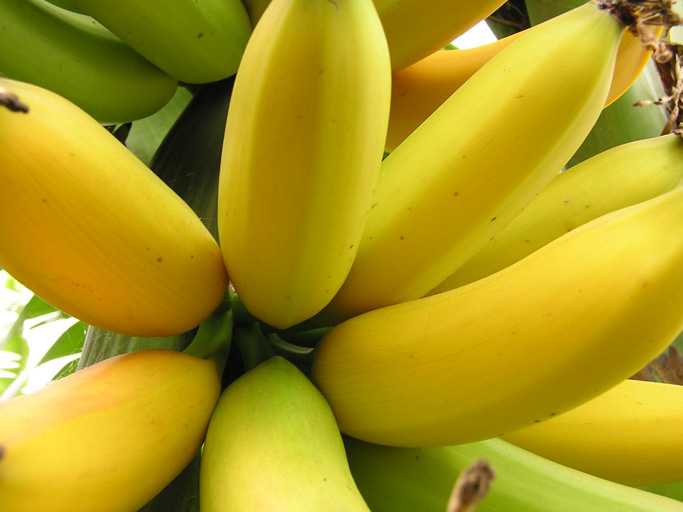
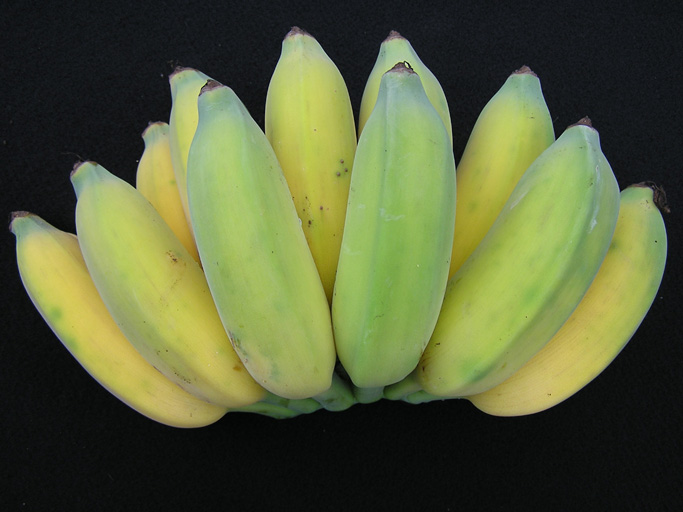
Fruit.

Beauty.
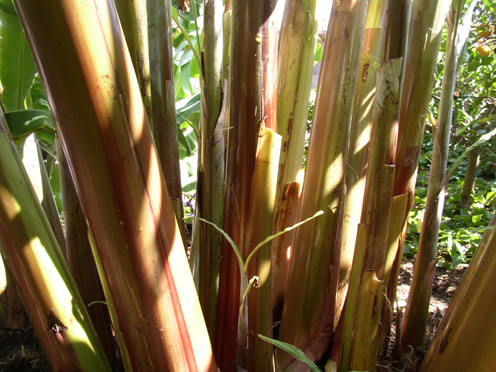
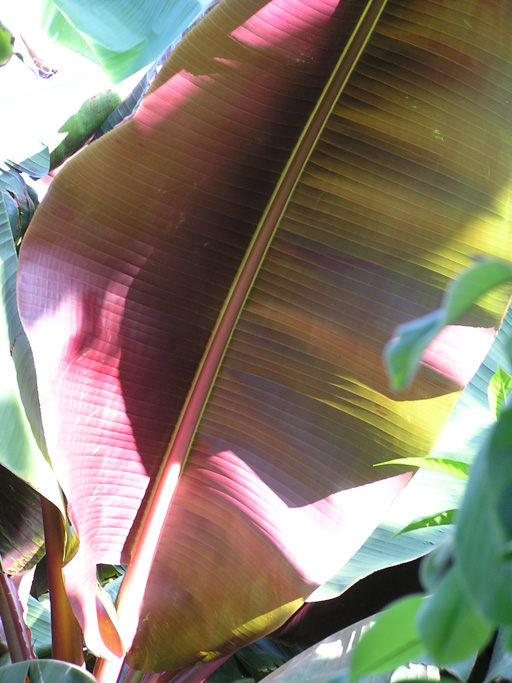
Landscape value.

Flavor.
3.
Culture: growth characteristics and conditions.
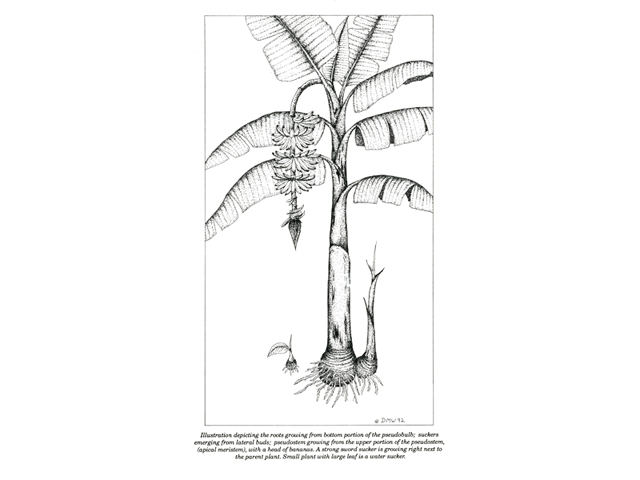
At this point we need to understand a small bit of biology.
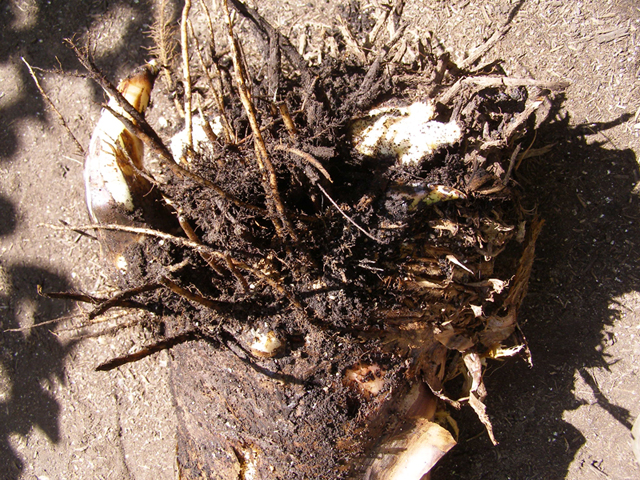
Banana plants grow underground, much like a tulip bulb.
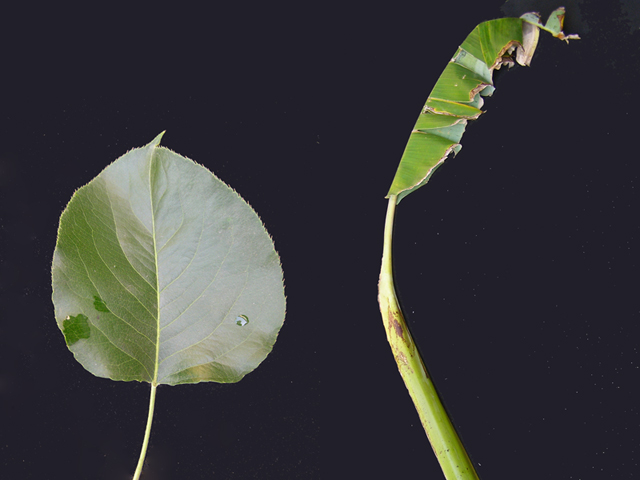
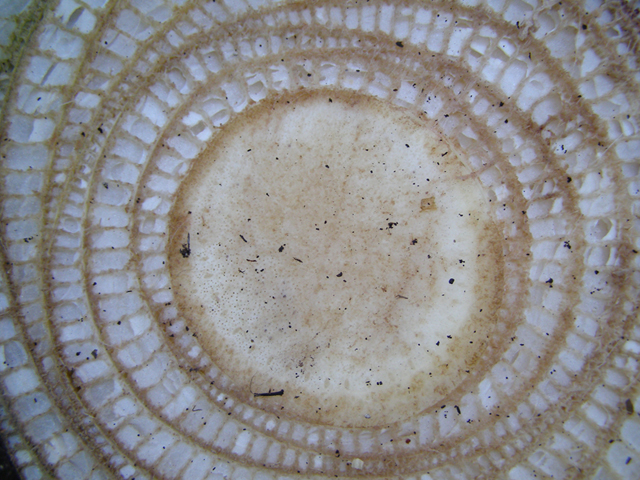
Everything you see above the surface of the soil is leaf. What we often refer to as the trunk is technically a pseudostem composed of a bundle of leaf stems. The strength of the trunk is derived from the curvature of the leaf stems, and the way they overlap. Narrower stems mean less overlap, and therefore potentially less strength. When the flower spike pushes its' way up through the center of the pseudostem it forces the overlapping leaf stems apart, decreasing their overlap, and weakening the stem.

Dwarf vs. Tall.
Broadly speaking, most banana plants which you are likely to grow have trunks which are 6' tall, or 12' tall, but some varieties are as short as 2' or as tall as 25'. One advantage of dwarf plants is that they usually do not require propping.
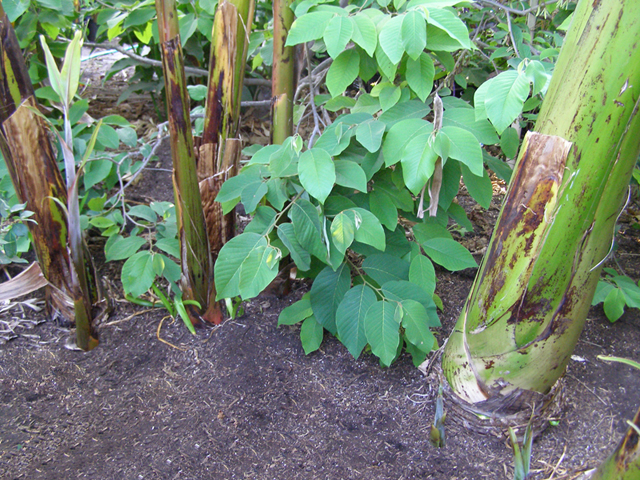
Slender vs. Stout
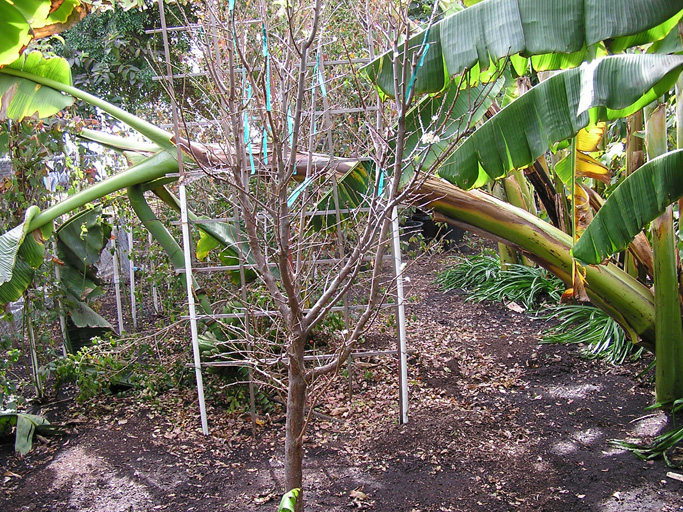
Slender plants will usually need propping, but some seemingly stout plants become very weak when they flower.
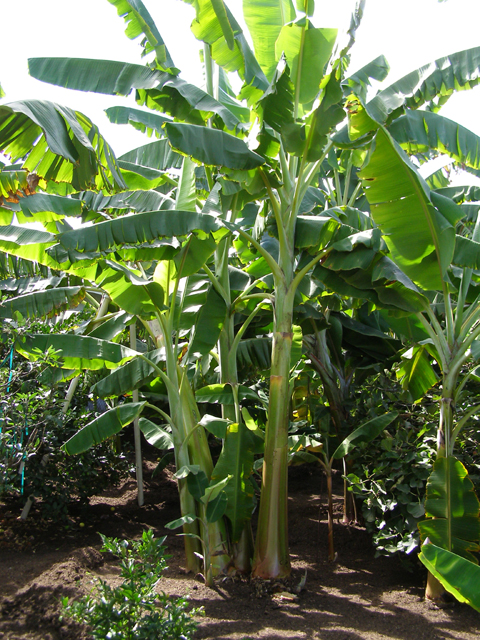
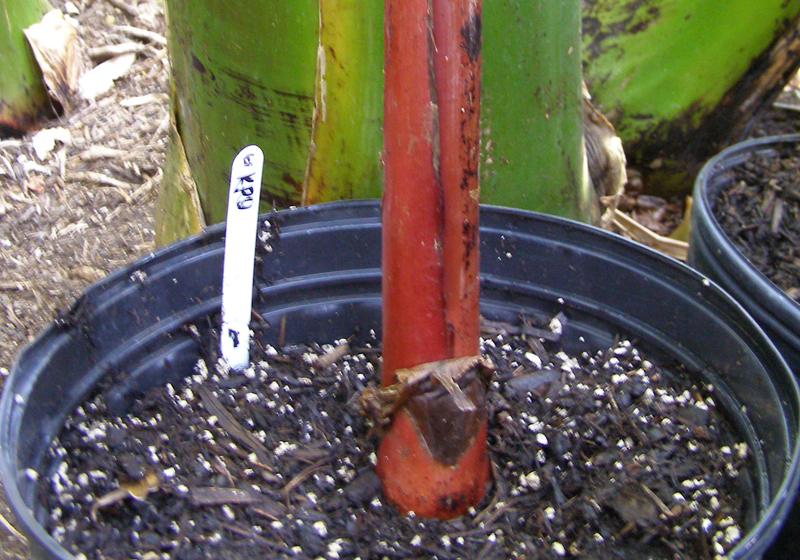
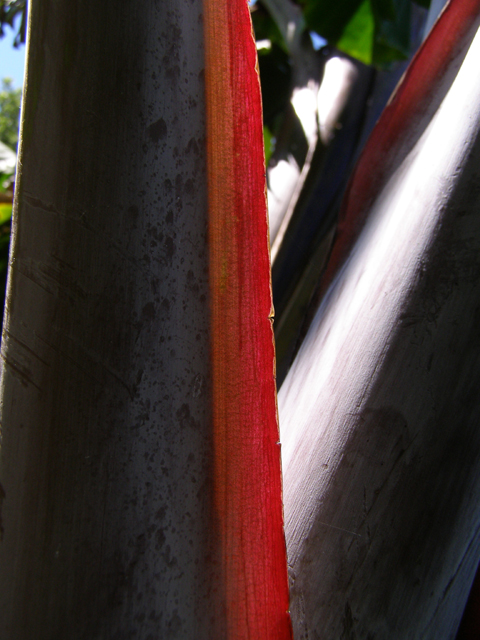
Different varieties have a wide range of colors, shapes and styles.
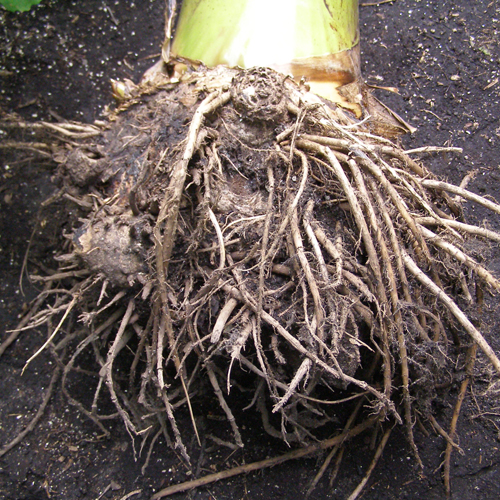
Roots can extend as much at 10' from the trunk of the plant.
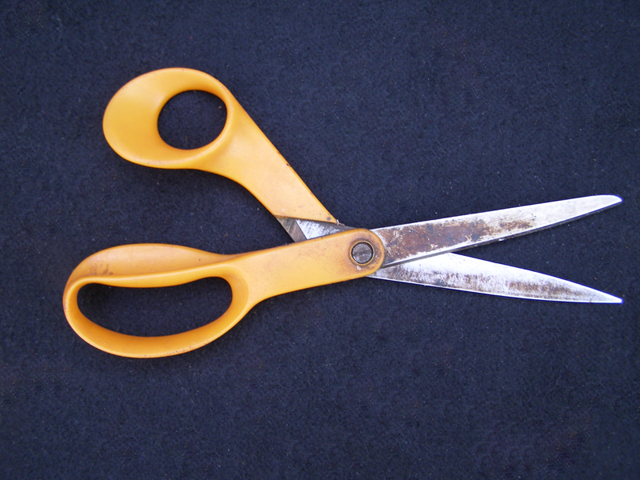
Pruning. All you need is a pair of scissors.
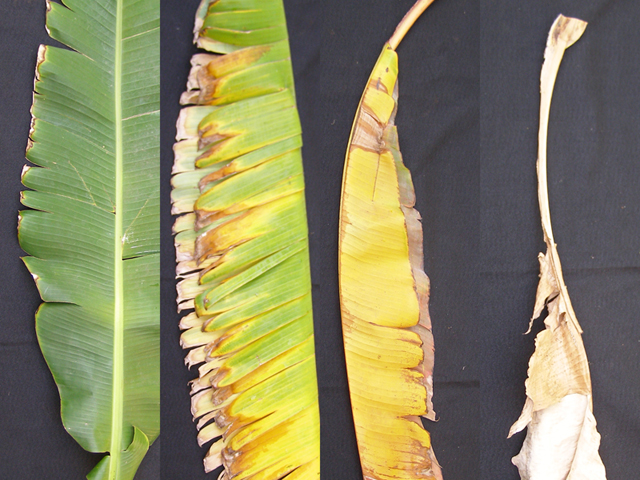
Anything green is good. Yellow and dry brown can be removed.

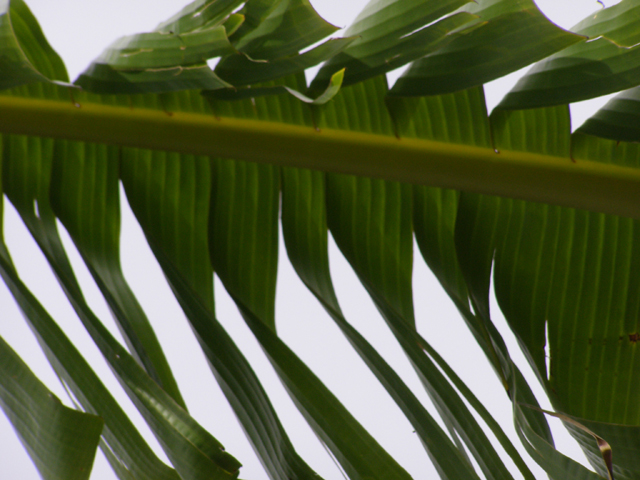
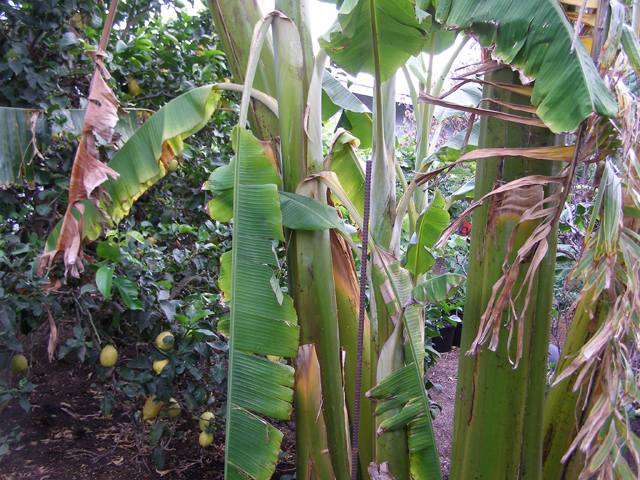
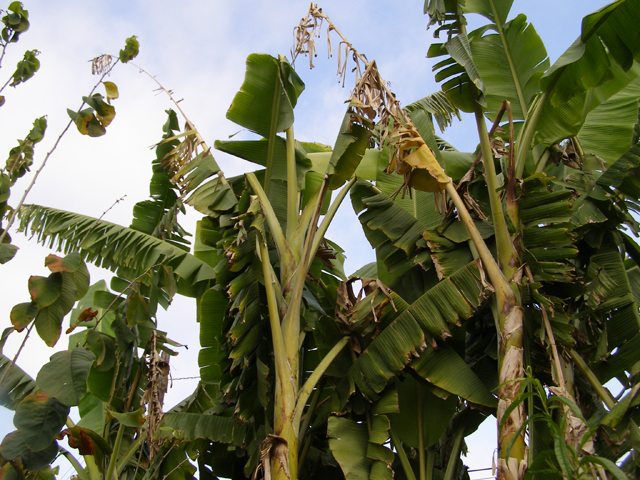
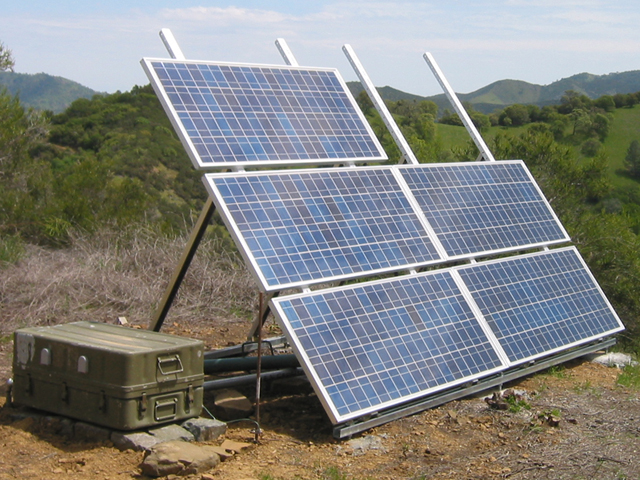
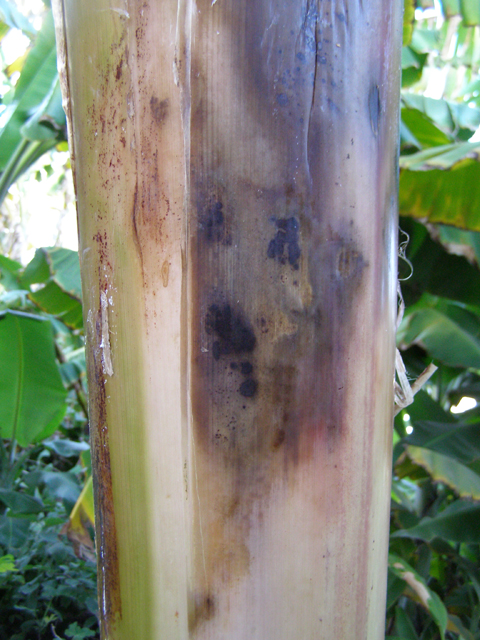
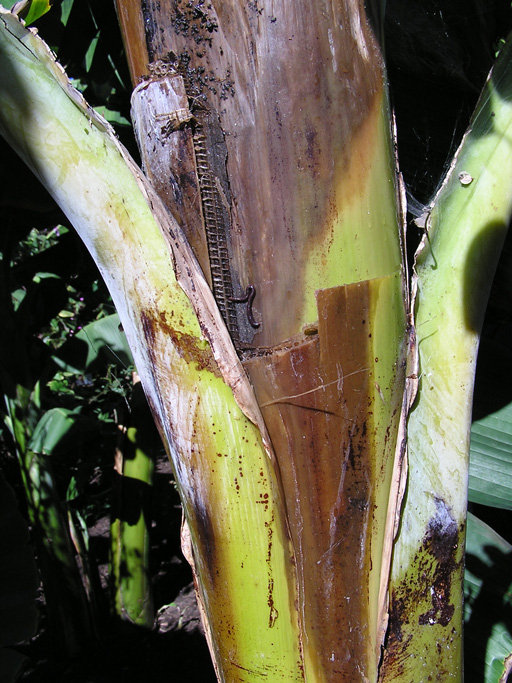
Wet, mushy, dark brown is rot and must be removed immediately, as it will migrate through the entire plant.
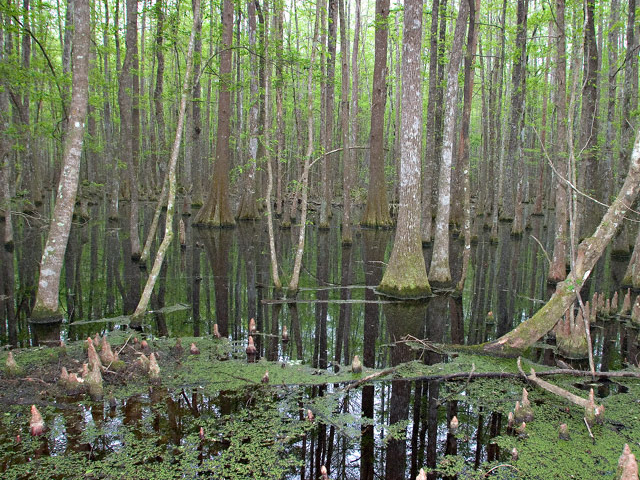
Water: Watering must match the growth rate of the plant and the season of the year.
Quick biology. Below 50ish degrees, plant metabolism decreases significantly, (as evidenced by reduced leaf production) and consequently requirements for water and fertilizer drop significantly, also.
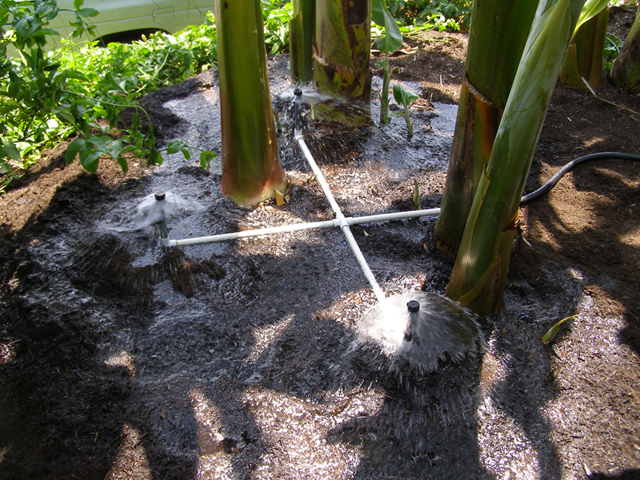
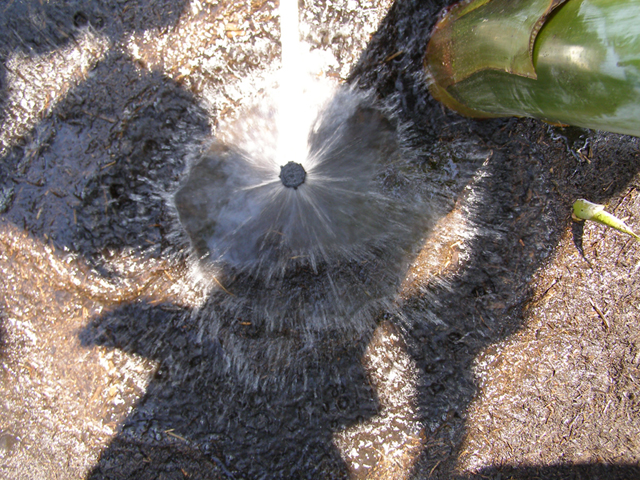
In the heat of summer, you almost can't overwater. In the winter (approx October to March in So Cal) you only need to maintain dampness. Overwatering will lead to rotting of the roots, stressing the plant, and ultimately reducing size and quantity of fruit.
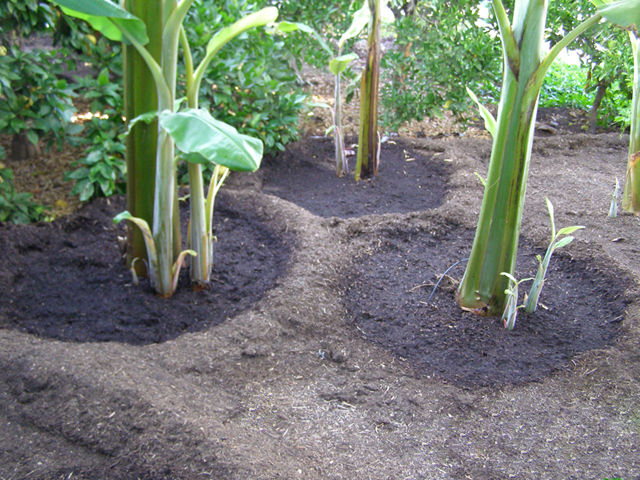
Spacing: I understand that 10' spacing is used commercially, but many of mine are planted closer. Often I plant in groups of 3, at about 6' spacing, but leave more space around the perimeter, before planting another group.
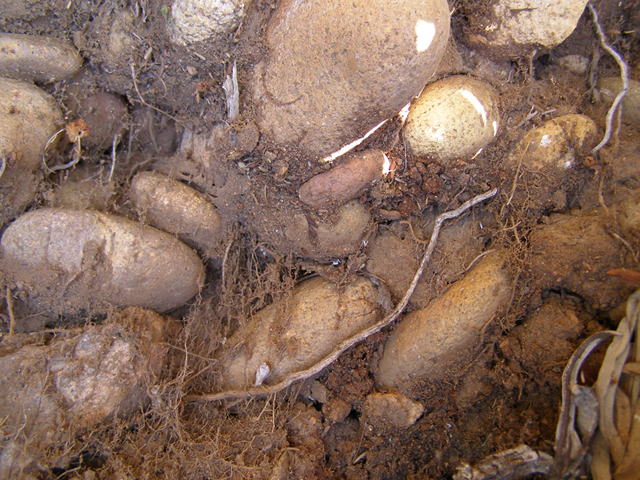
Soil: Soil type is almost irrelevant. The plants are shallow rooted, 12-18" deep at most. Most of mine are in heavy clay and cobble. Some have been planted in pure compost. There are reports of them thriving in piles of horse manure. The important issue is matching water application with soil or drainage type. Perhaps the most challenging soils are sand and decomposed granite, which do not hold water well.

Because of their shallow nature, they could most likely be successfully raised in an appropriately large raised bed.
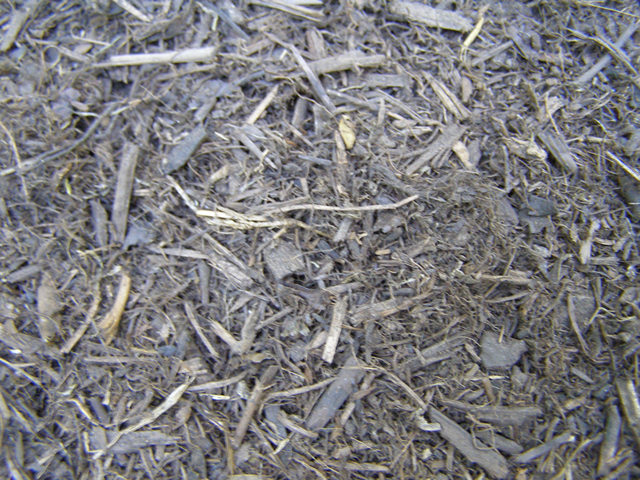
Mulch: a good, heavy layer of compost or other similar organics on the surface of the soil is important.
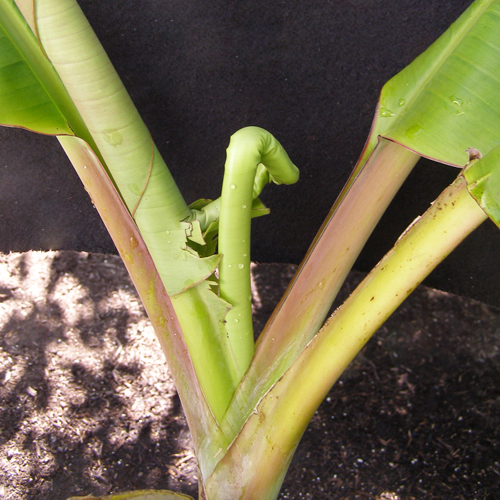
Fertilizer: when weather is warm, and plants are actively growing, you almost cannot over-fertilize. The only ill-affect of extreme fertilization that I have seen is expressed in tangled leaves on some varieties which have a particular leaf-emergence style, e.g. Manzano.
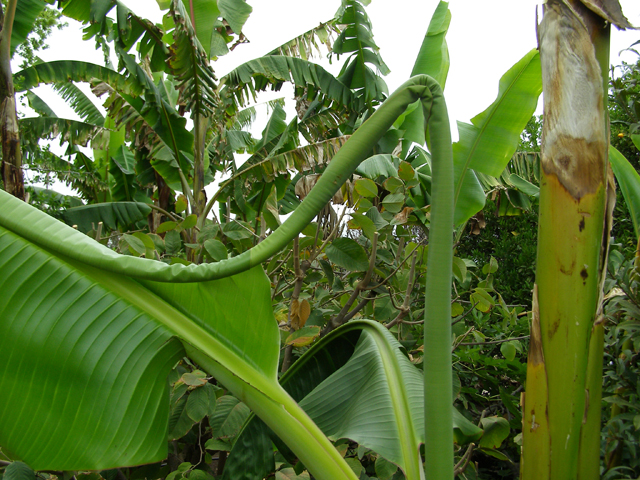
The supposed optimum ratio is 9-3-27. However, in my experience, I could not see any difference between the optimum and 16-16-16, which is cheaper and easier than mixing 21-0-0. 16-16-16 and 0-0-52 to achieve the "optimum" ratio.
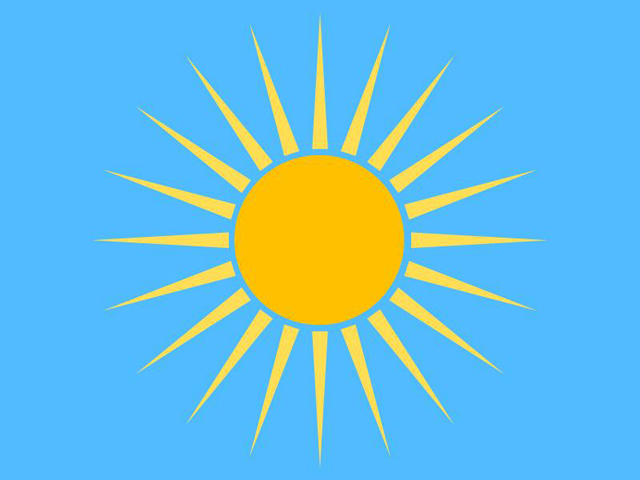
Location, siting and weather. More sun is good, up to about 95 degrees (see Arizona chapters for extreme heat conditions).
Less wind is good.
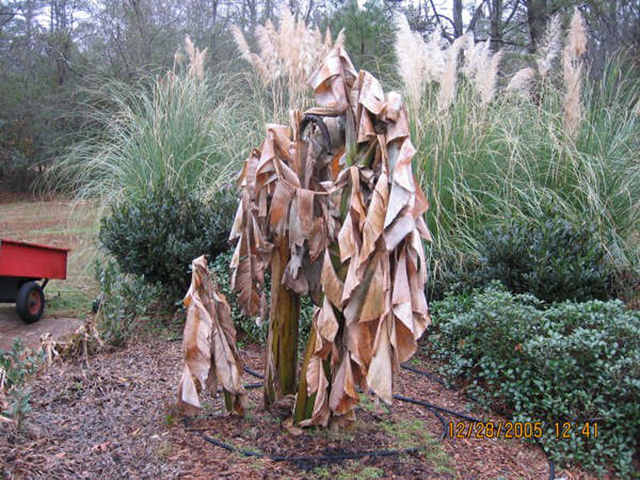
Frost is bad. In many case they will recover, but the loss of leaves will stress the plant and reduce size and quantity of the eventual fruit bunch.
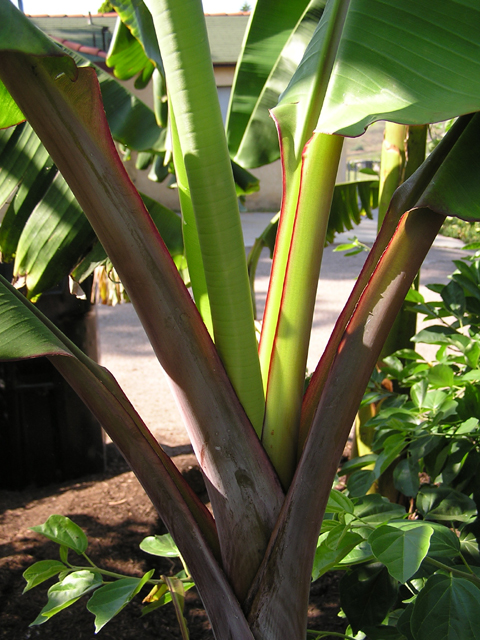
Cold tolerance: see Joe Real's list.
Generally. Red bananas are less cold tolerant (Tall Red, Dwarf Red, Cuban Red, Kru Red Iholena, Red Green, Dwarf Red Green, Rose), though some green bananas are fairly tender as well, such as Kumunamba and Kofi, and to a considerable extent, the Cavendish varieties.
Most Reds will barely survive mid 40's for extended periods.
Flowering, in winter (induced by an unusually warm week), or after a long winter can impact fruiting (size and
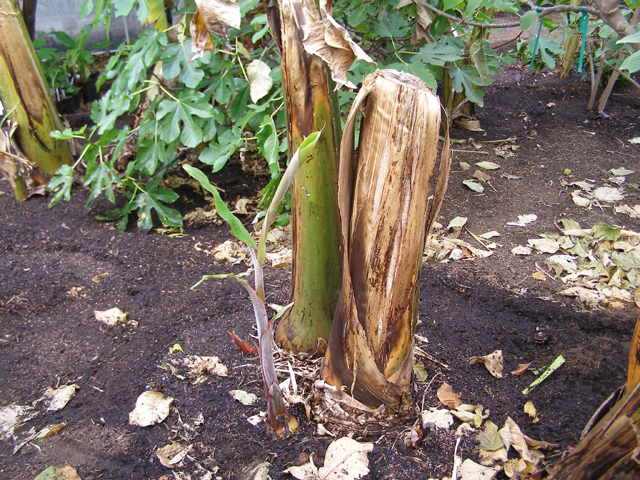
Mat management: try to keep 3-4 plants in you "mat" (clump), of varying sizes and maturities, approximately 6-9 months apart. This will give you a more consistent harvest. Some varieties seem to be more affected by crowding than others.
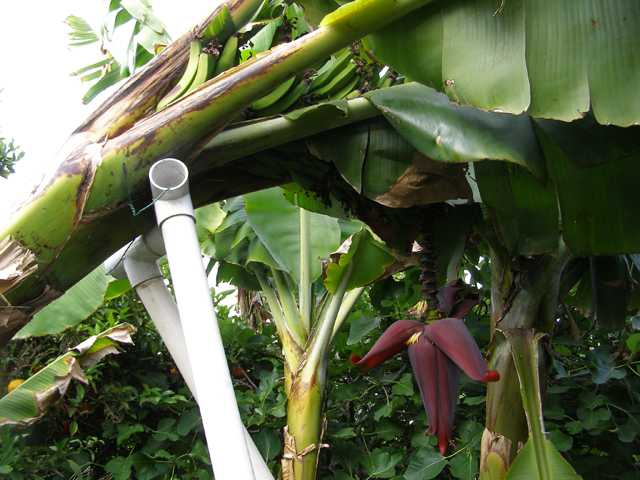
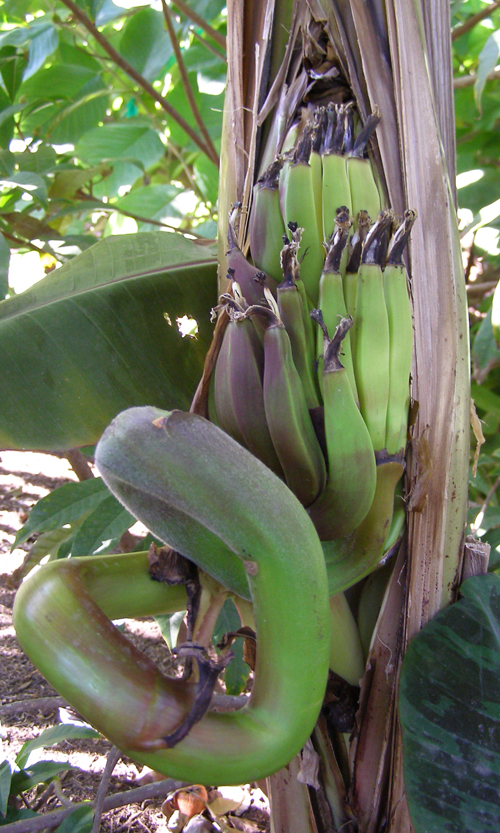
Choking: some varieties, such as Raja Puri, Fhia 17 and Sumatrana X, are susceptible to choking, which is a condition where the flower does not fully exit the pseudostem, and the fruit are formed inside the pseudostem. Or the flower may even erupt through the side of the pseudostem instead of exiting the top of the pseudostem.
4.
Flowering and Harvest.
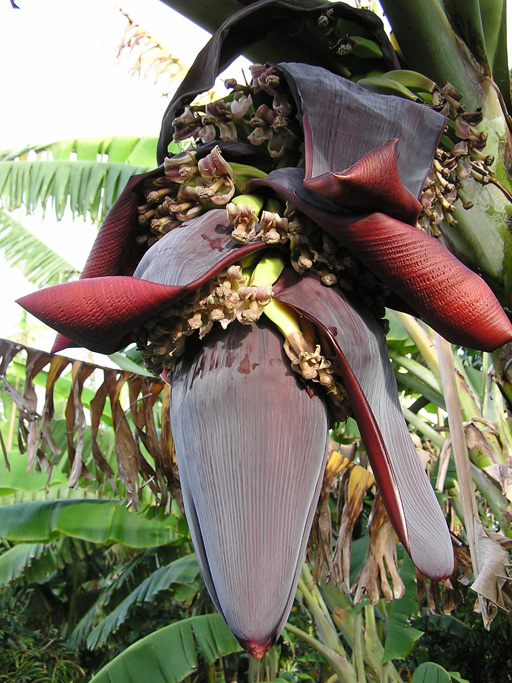
Once again, knowing you particular variety's characteristics is crucial. I cannot give you a list of ripening times for each variety, but I can teach you how to determine your varieties characteristics.
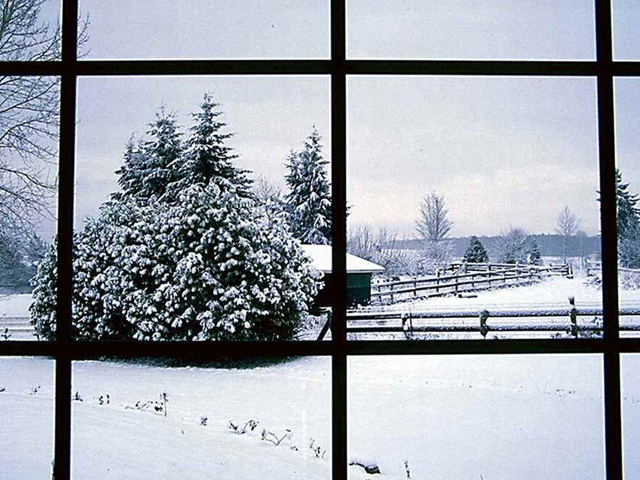
Season: there is none. They flower when the "feel like it". Many sources suggest they flower after producing a certain number of leaves, but the sources vary widely on what that number is.
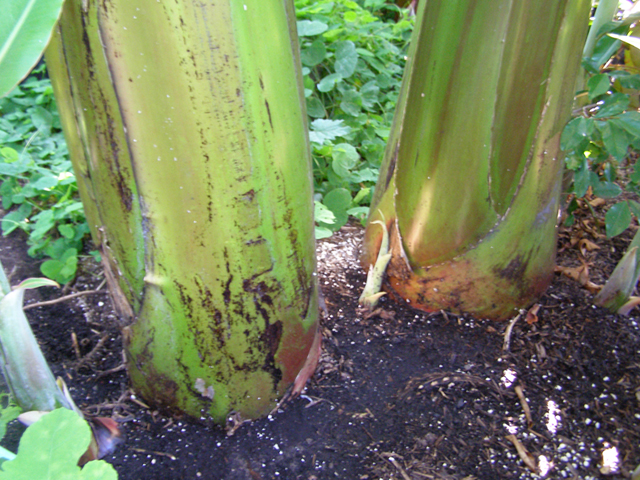
Signs of flowering include: Increase in trunk diameter,...
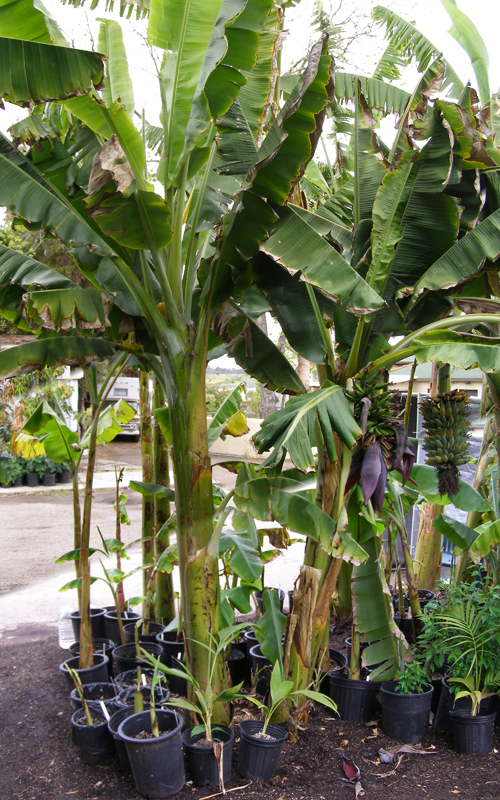
...spacing or bunching of leaves, (Not BTV),...

...and or pseudostem gets "droopy", e.g. Thousand Fingers.
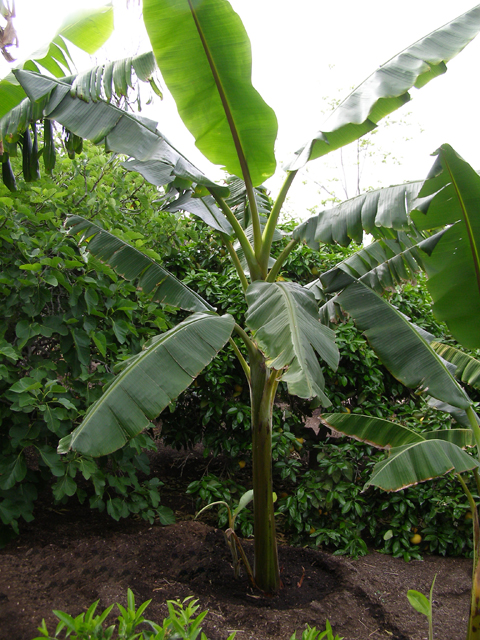
Pseudostem height is the best indicator of closeness to flowering. With consistent culture (water, fertilizer and weather) each variety will, flower at almost the same exact height each time. I am seldom surprised to see a plant flowering and can usually tell within a few weeks, when my plants will flower.
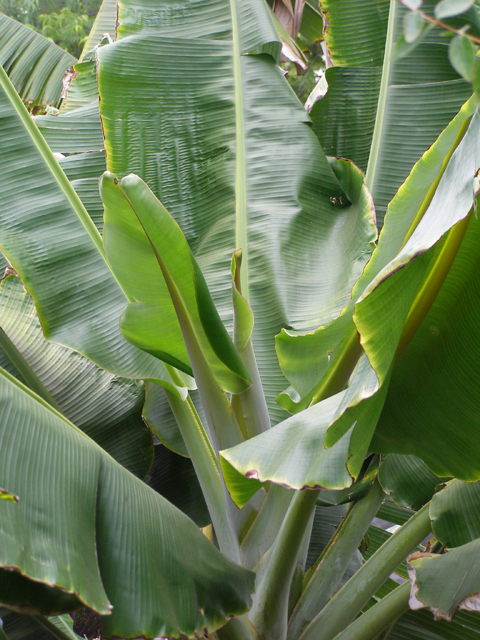
Flag leaf.
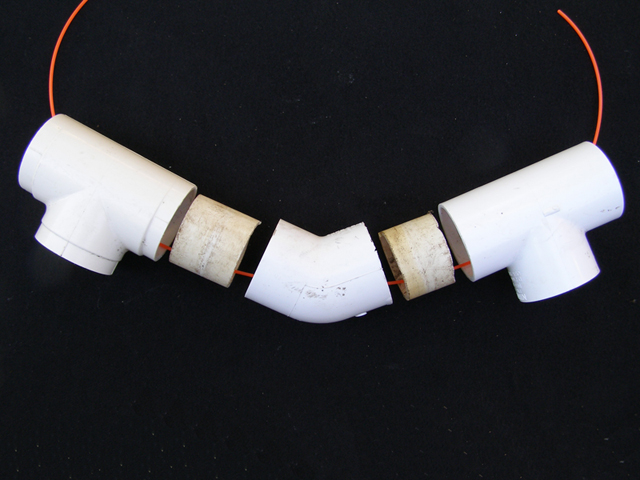
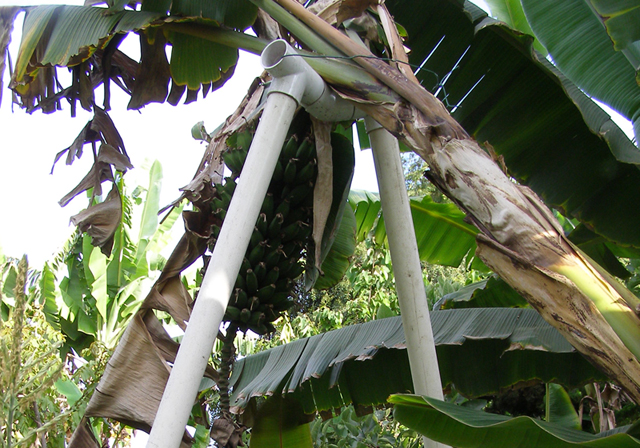
Propping.
There are many ways to accomplish this, but this has been simple and very successful. The secret is the 45 degree elbow, which naturally allow the legs to be spread apart, giving very good side-to-side stability (shear resistance for engineering types). 2" PVC has much greater strength than 1-1/2". Anything larger is not necessary. It is important, when using any form of propping or staking to support the weight at the very top of the bunch. Propping at any point lower on the trunk usually ends with the pseudostem folded or broken at the support point. You want to support the banana bunch as if you had removed them from the plant and had hung them up to ripen.
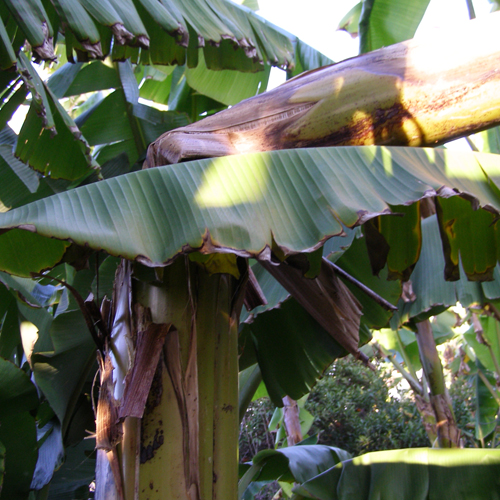
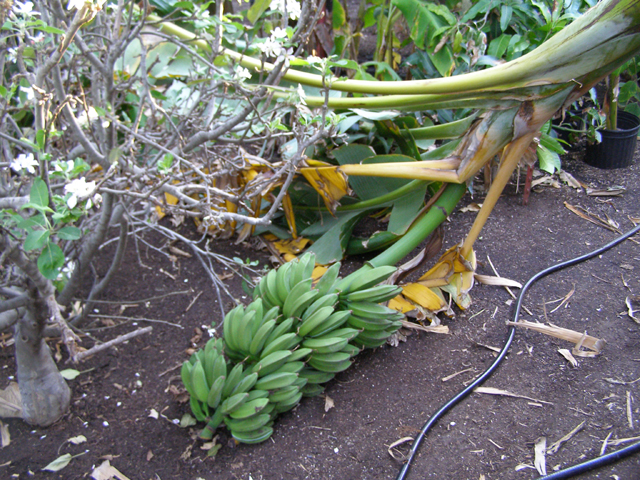
Even if the plant if "folded" by the wind, as long as there is some connection remaining in the flower stem, the fruit will ripen normally. It is better to leave the damaged stalk "as is" rather than damaging it further by trying to straighten or move it.
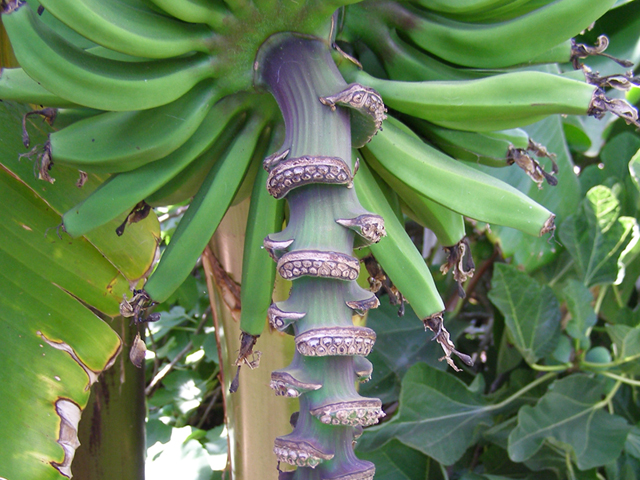
Flower removal.
The literature is divided down the middle. I haven't been able to determine an affect either way, but assume that energy going into endless male flowers must not be going for other things. If you remove the flower, leave about 12" of stem below the last hand of fruit. If the stem desiccates up past the point where the fruit is attached to the stem, that fruit loses connection with the plant, and will usually not be edible.
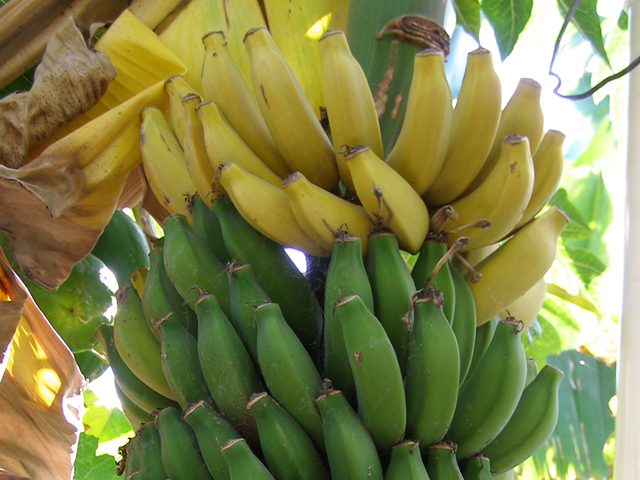
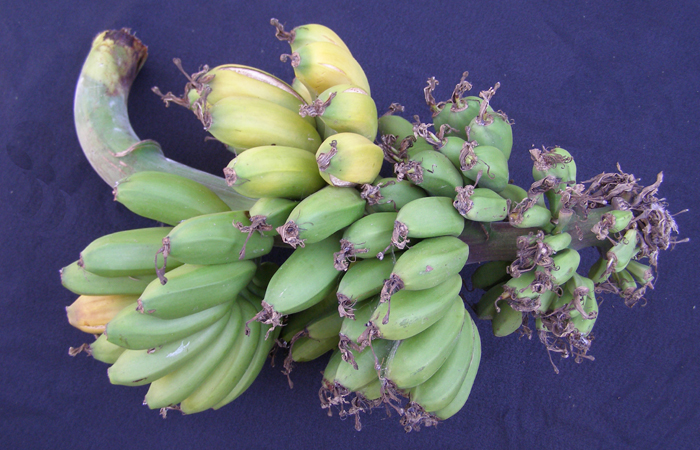
Signs of maturity and ripeness (different things).
Maturity and ripeness are two different things. Mature bananas may be picked green and will ripen off of the tree. This is how all commercial bananas which you purchase in the supermarket are done. Immature bananas will not ripen properly. Hanging time on the tree, to achieve maturity is different for each variety. I have ripened Kru fruit after only 6 weeks hanging time. However, my first bunch of Saba fruit required 11 months on the tree before ripening.
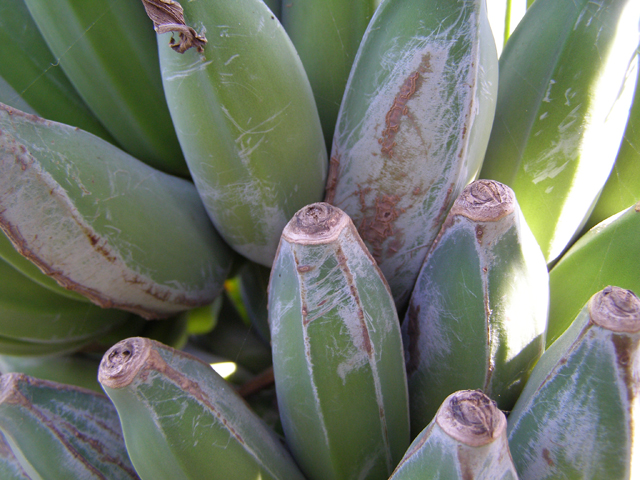
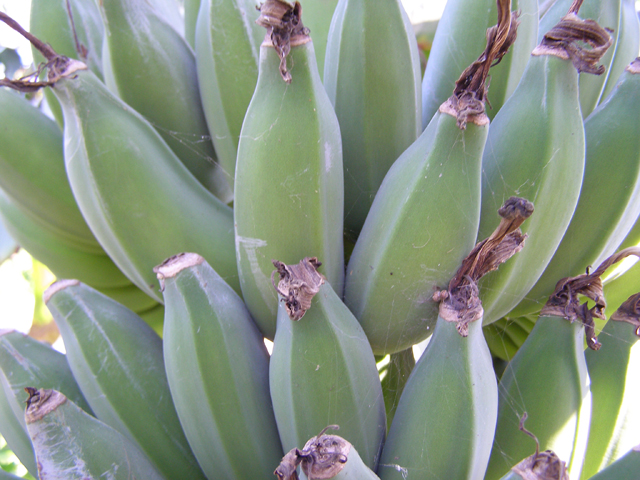
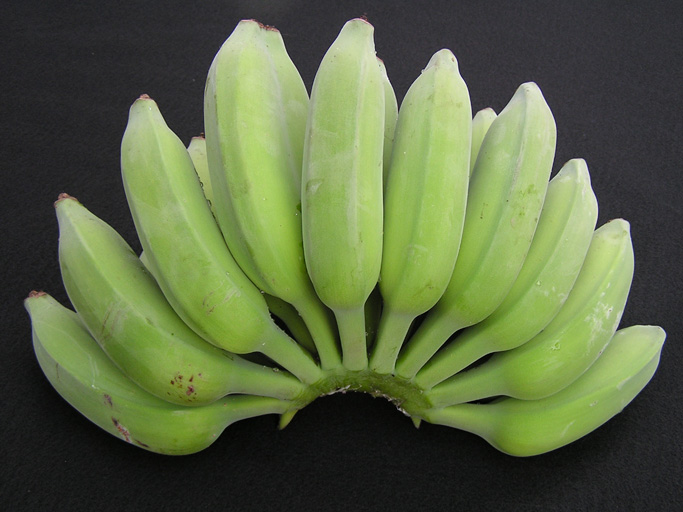
Plumping and/or rounding of the fruit. This is very pronounced in some varieties, and almost unnoticeable in others, is evidence of maturity


Color change is evidence of ripening. Different varieties have different shades of yellow when ripe. Once again, becoming familiar with your particular variety is crucial.

Even Ebun Musak, which is green when ripe, has a slight color change. It is important to know when to look for that color change.
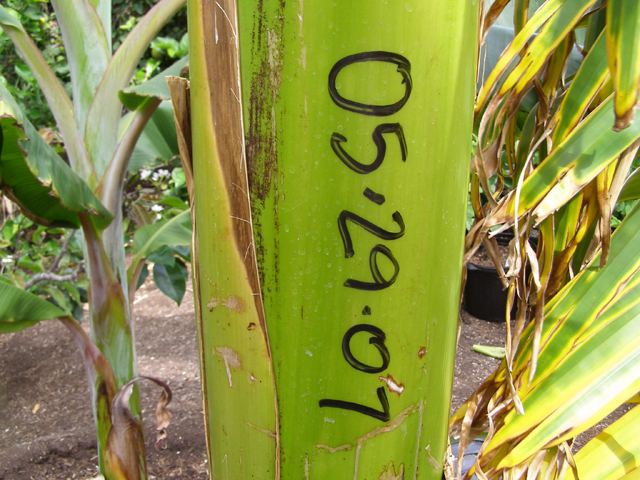
Harvest.
Knowing when to pick your bananas is the final step in enjoying your harvest. I approach each new variety this way: when the first hand (not the flower) appears, (this is the most important step) I write the date on the side of the stalk with a felt pen. After 6 months, if they have not shown any color change, I cut off the top (oldest) hand, and allow it to ripen (usually in a couple weeks). If it is OK, I continue removing hands as I need them. Eventually the rest will ripen on the “tree”.
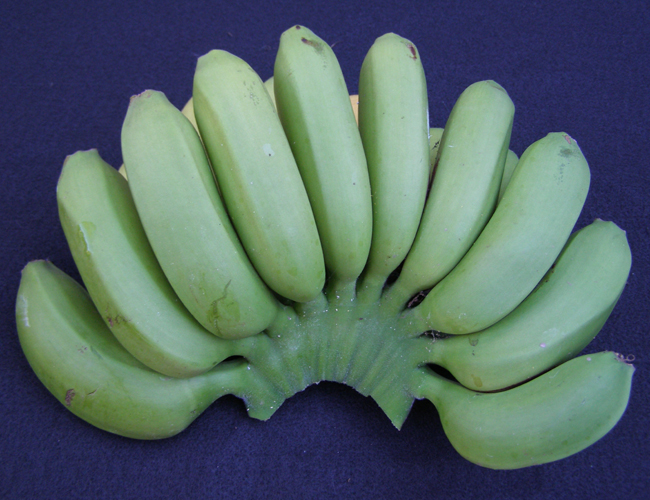
Picking when green spreads out the harvest (who wants to try and eat 100 bananas in a week?). Once, again, it is very important to become familiar with your variety at your location with your climate.
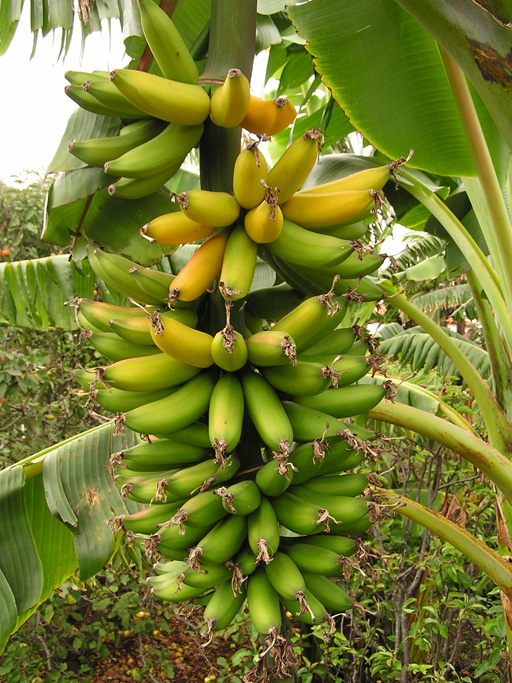
If the fruit has been hanging all winter, it may be mature, but won't ripen without proper conditions. It will have a tendency to ripen during the first warm week, which often occurs in early April in San Diego. In this circumstance, it is difficult to spread out your harvest.
Kanderian ripens in about 10-12 weeks; Saba has taken as long as 11 months. "Your results may vary. Details in store."
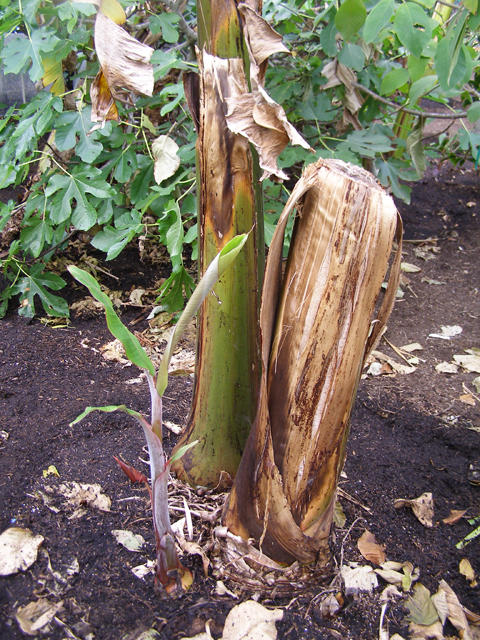
After Harvest.
5.
Since your banana plant will only flower once, and then die, you need to know how to make additional plants.
The banana plant only flowers once and then it dies. I leave the old plant as long is it has green leaves, on the theory that it is still contributing energy to the mat (group). When the leaves have faded, and the trunk begins to desiccate, I remove it in stages, till only the old corm remains. Some varieties, e.g. Belle, may have green leaves for close to a year. With others the trunk and leaves will barely last long enough to mature the fruit.
Propagation.
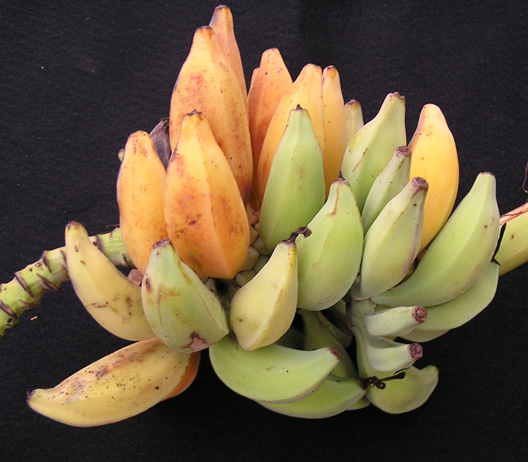
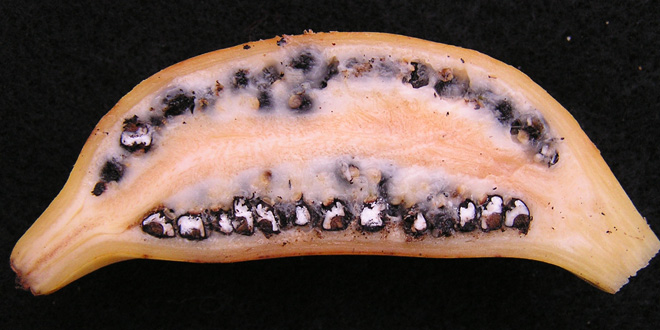
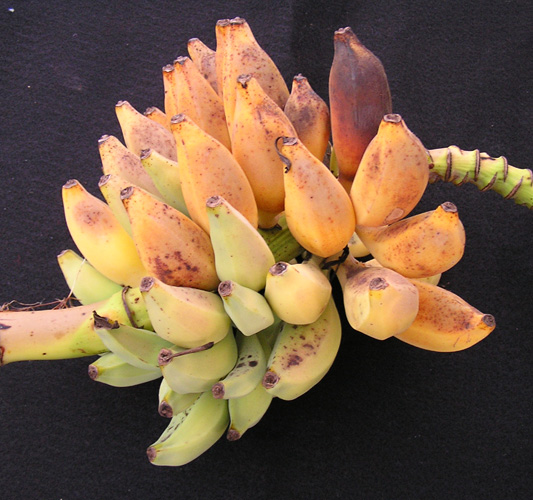
Ornamental varieties grown from seed.
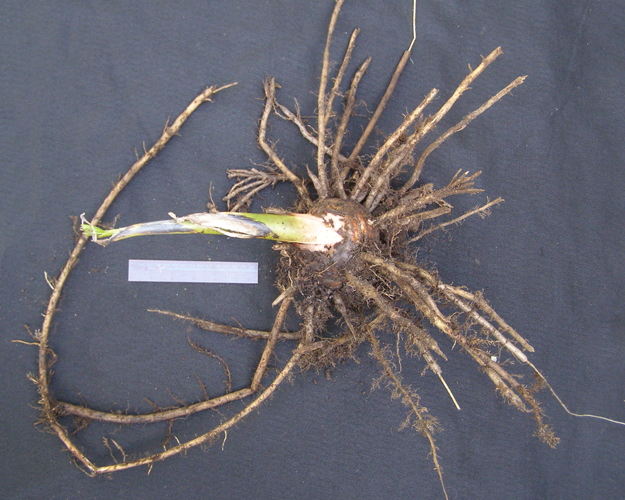
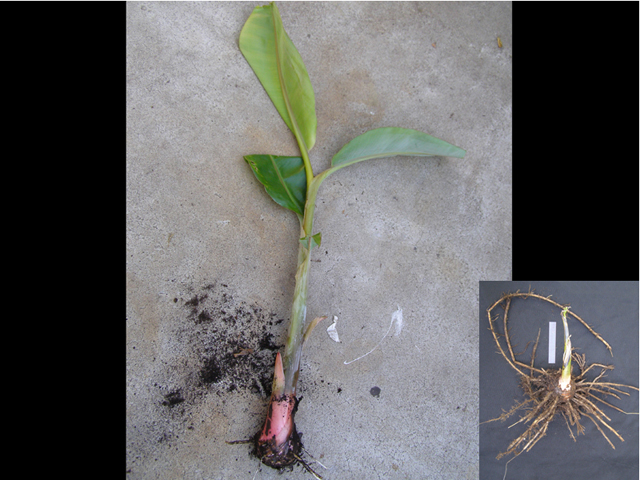
Edible varieties grown from pups or Keikeis (Hawaiian term). Pups form by growing up from the existing corm or plant. The number of pups varies by variety. They from at different times, also depending on variety. Some grow when the parent plant is quite young, while others only start growing when the parent plant has flowered. Most pups, called sword pups, grow 2-3' before growing regular leaves. However, some, called water pups have leaves when very short, and generally, but not always, are less vigorous and poor growers.
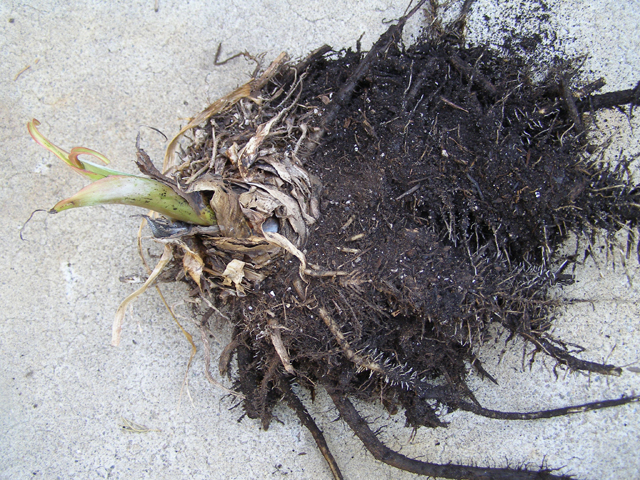
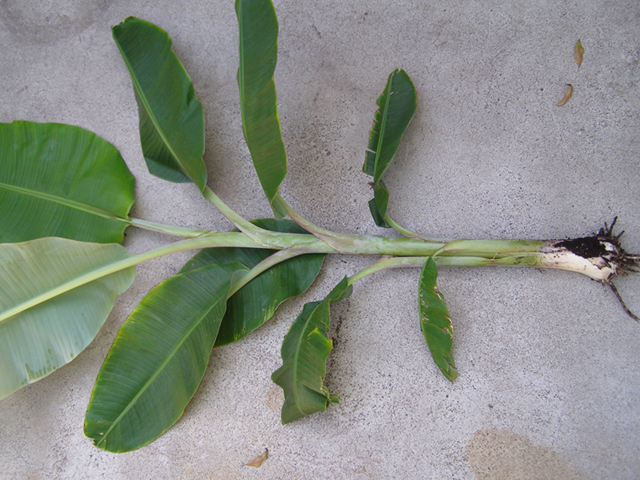
Corm size.
I generally remove my pups when they are about 16" tall. But some pups of that size are already too well rooted to remove easily, and others will have little or not roots at that size. Getting to know your variety is important.
It is best to take pups when there are still a few weeks of warm growing weather, so that they can callus and grow roots before going dormant in cooler weather. This reduces the chances of over-watering and rotting the pup.
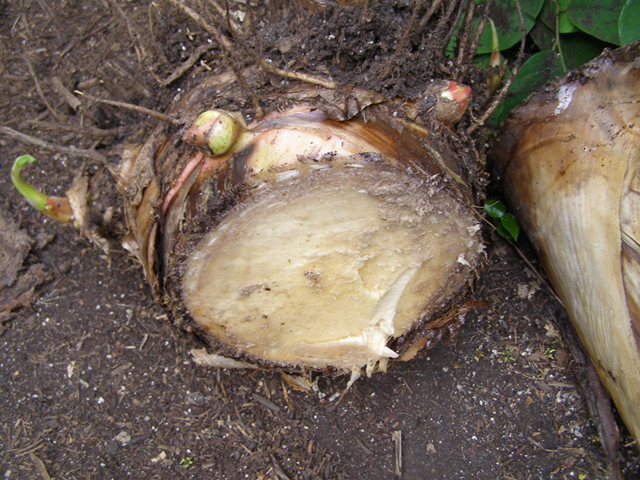
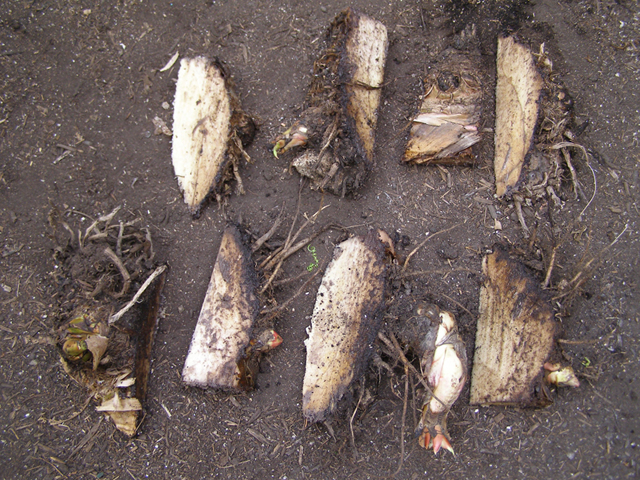
Plants may also be propagated but dividing up a corm, much like a potato, and planting the "eyes" or small pups which are forming.
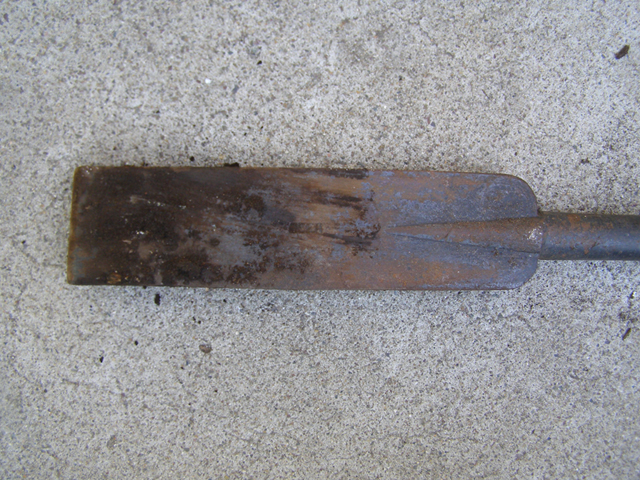
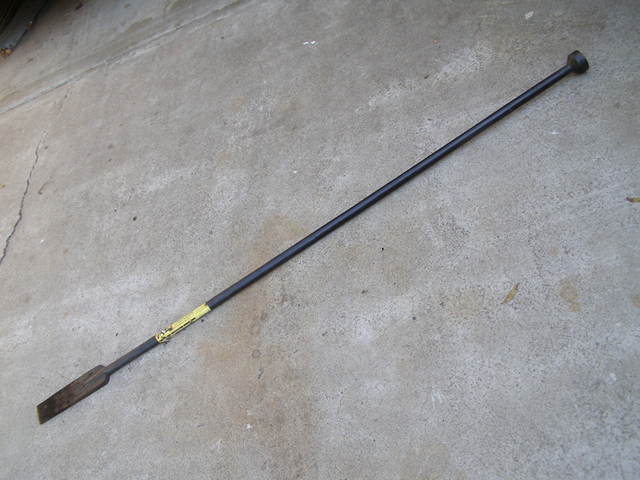
Tools.
I use a RoughNeck digging bar. I have tried many different things such as a shovel, spade, narrow spade, trenching shovel, the Mutt, and some homemade tools as well, and this has become my tool of choice.
Important factors and issues.
Minimizing root disturbance of the parent decreases stress, and less stress is ultimately rewarded by better fruit production..

Stress
Removing pups close to flowering greatly stresses some varieties, e.g. the Cavendish varieties.
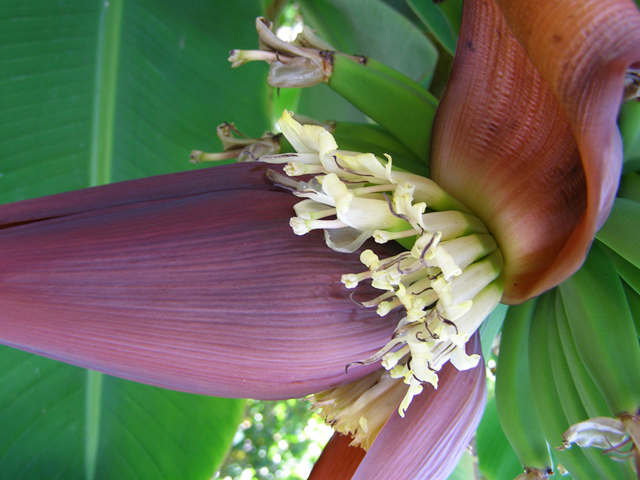
Different characteristics.
6.
Plant size.
Quantity of roots.
Corm size.
Time of pupping. Some varieties pup very early, some not till flowering.
Never give up.
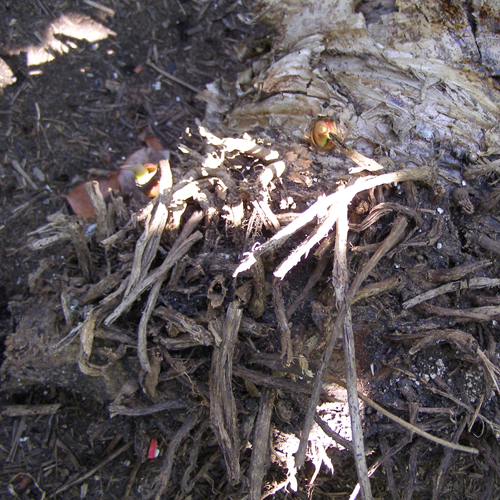
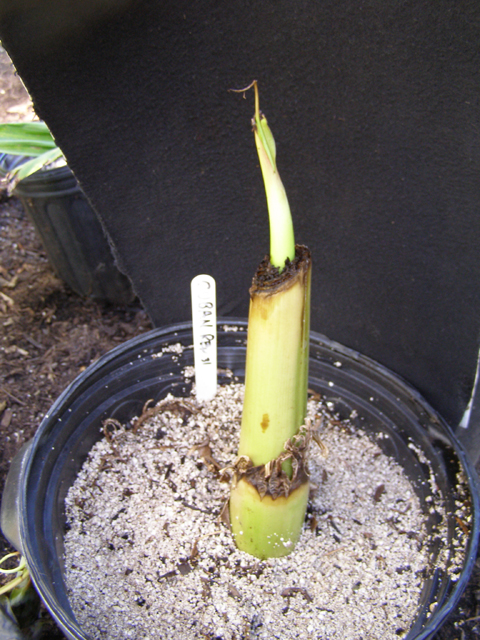
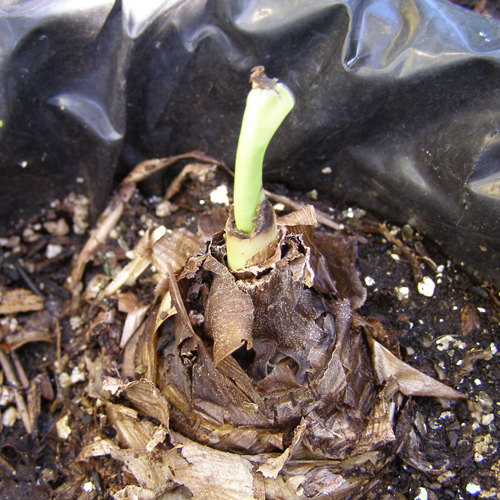
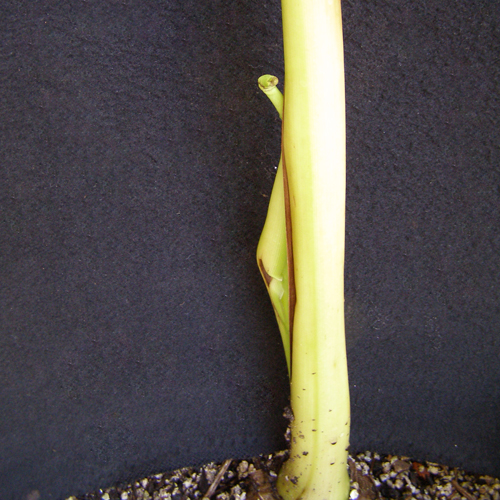
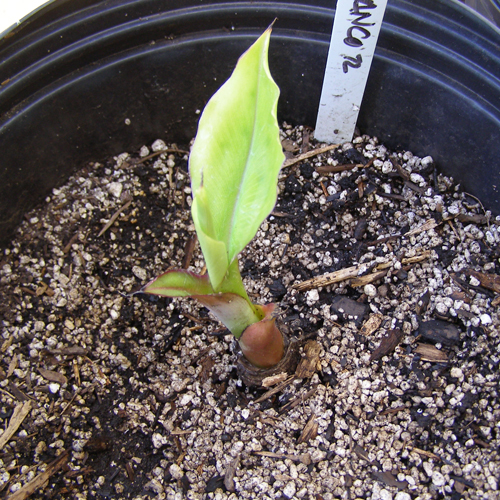
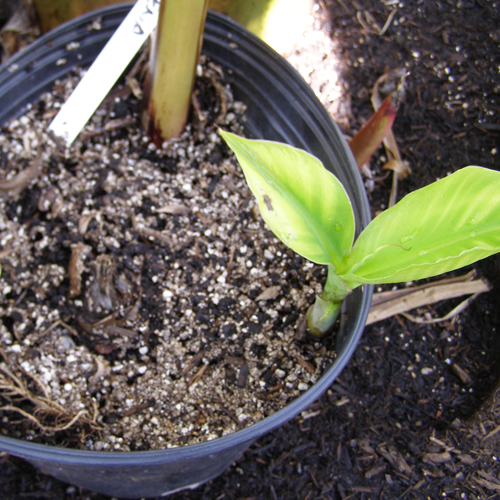
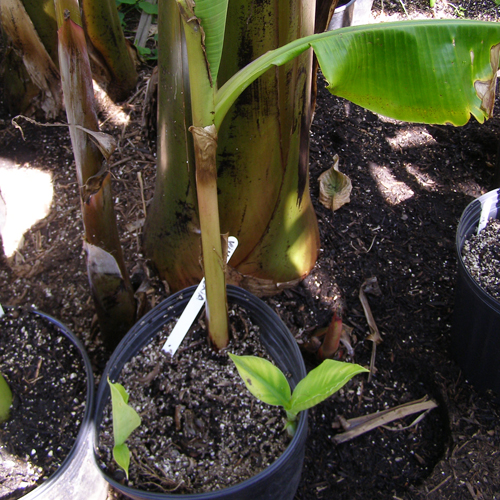
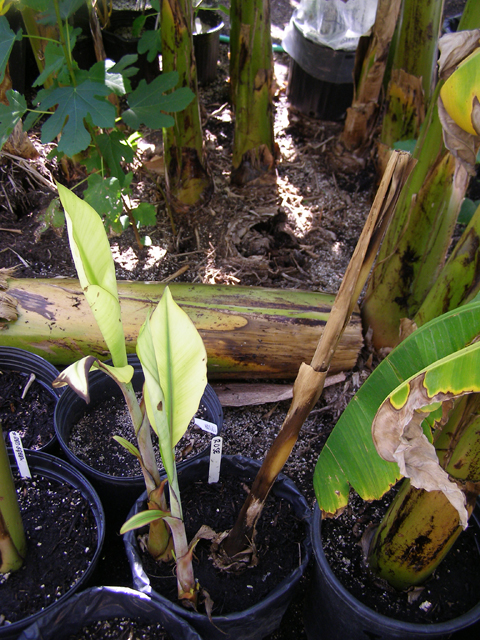

Folded plants.
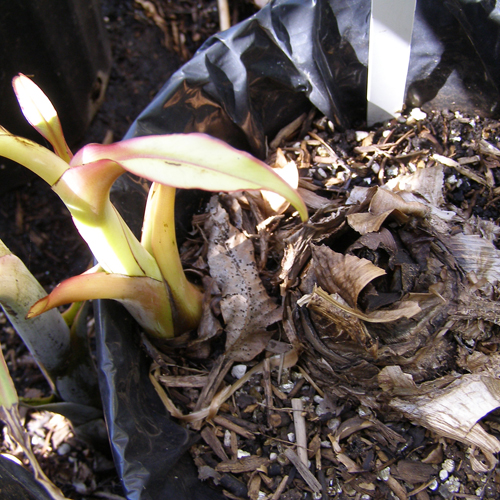
Seemingly dead plants.
7.
The plant or corm is underground, so what you see above ground my not reflect the reality underground. Never give up until there is literally nothing left but a hole in the ground.
Best tasting.



The one I am eating.
8.
The one that is getting ripe.
The one I have for sale.
Literature and resources.
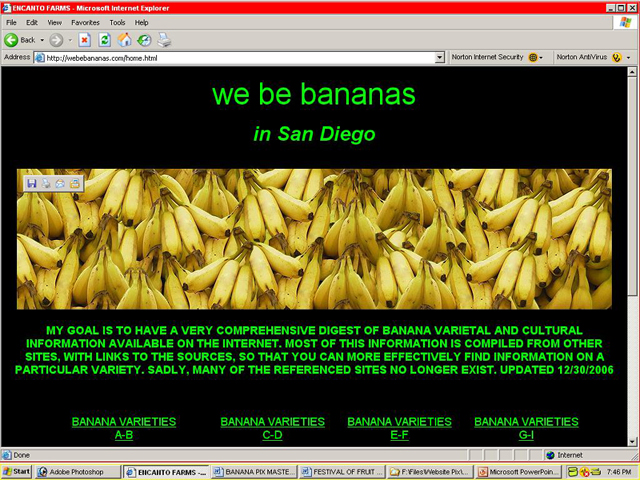
We Be Bananas http://webebananas.com

FHIA http://www.honduras.com/fhia/
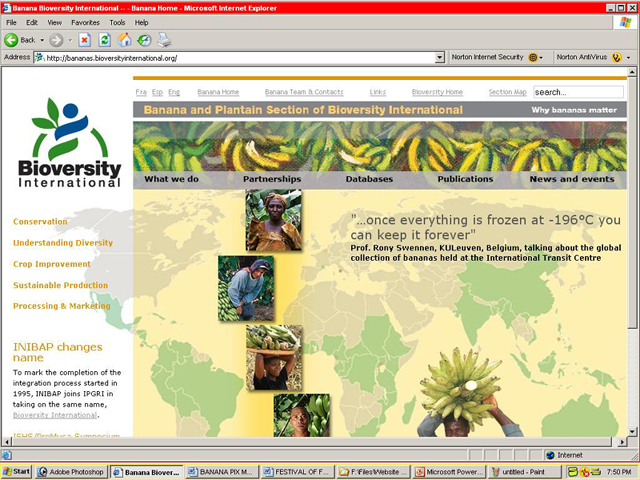
INIBAP http://bananas.bioversityinternational.org/
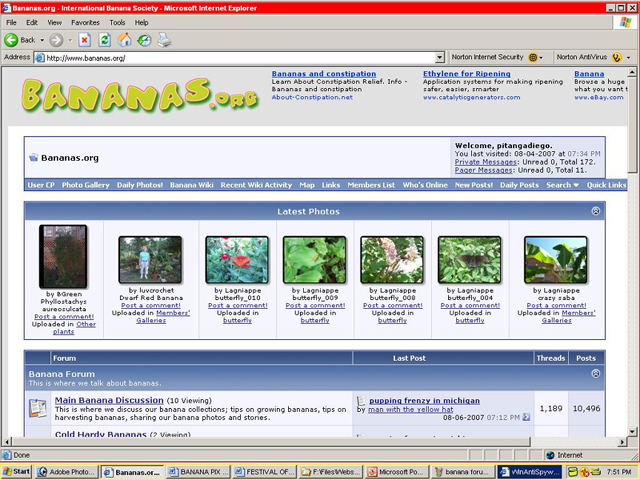
Banana.org http://www.bananas.org/
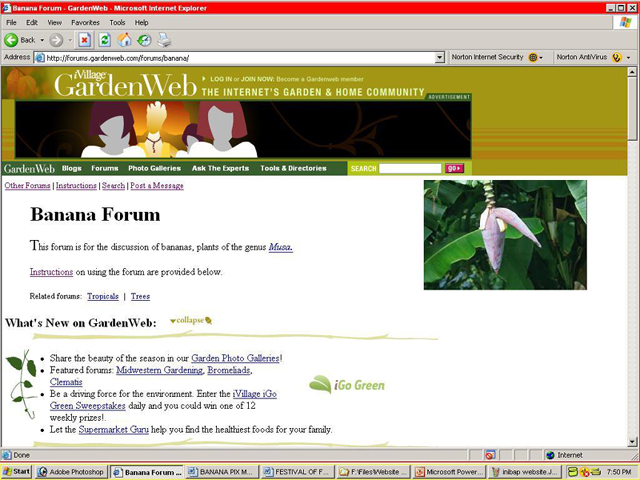
Garden Web Banana Forum http://forums.gardenweb.com/forums/banana/
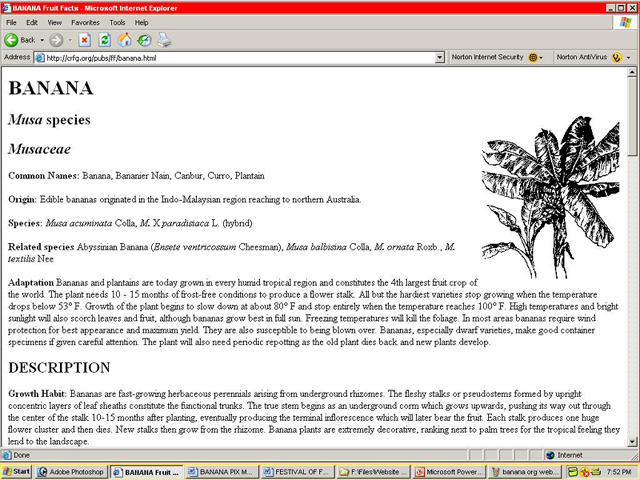
CRFG Fruit Fact http://www.crfg.org/pubs/ff/banana.html
Joe Real's Cold Hardy List, from most hardy to least:
California Gold
Thousand Fingers
Monkey Fingers
Orinoco
Brazilian
Golden Rhinohorn
Dwarf Orinoco
Dwarf Brazilian
Misi Luki
Mysore
Namwah
Raja Puri
Manzano
Ice Cream
Gold Finger
Dwarf Namwah
Sweetheart (FHIA 3)
Namwah Pearl
Praying Hands
Saba
Cardaba
Williams
Belle
Valery
CRFG Banana Specialist